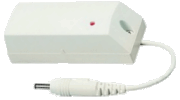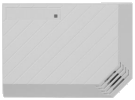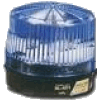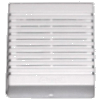Motion Detectors


Doors and Windows


Glass Break Sensor: A glass break sensor will trigger the alarm when it detects the noise or vibration of glass breaking.
The model on the left is attached directly to the window and can only determine if that window is broken. These are usually used by businesses on large plate glass windows.
The model on the right can detect any glass breaking within a given distance and are usually mounted toward the center of the home or near an area with a lot of windows.
In the example floor plan above, the glass break sensor is facing the rear exit glass door. Dropping a glass or loud noises can sometimes trip a glass break sensor and set off the alarm. The quality and sensitivity setting of the alarm control this behavior.
Motion Detector: Motion detectors will trigger the alarm when they detect motion in their area of coverage. Typically these are not installed on the second floor. You don't want the alarm going off when someone goes to the bathroom in the middle of the night. Motion detector usually have 90 degree area of coverage, so installing them in the corner of the room works best.
Motion detectors should be installed in every major room of the home. Some motion detectors will detect small pets and set off the alarm, while others are designed ignore pets up to 40 or even 80 pounds. Be sure to review the specifications of the sensor before purchasing.
Note: Usually motion detectors are referred to as PIR (Passive InfraRed) sensors. Some sensors utilize both PIR and microwave sensors for increased reliability.
Water Sensor: 24 hour Water sensors are used to alert you or your alarm monitoring company in case there is a water leak.
Typically, water problems occur in the laundry room when one of the flexible hoses to the washer bursts, in the basement near the sump pump, or near the furnace if the water run off from the air conditioner backs up.
Some water sensors / alarm systems are capable of turning off the water when a leak is detected. Since the sump pump should be near the lowest part of the basement, if you only have one sensor in the basement it should be near the sump pump.
Smoke/Heat/CO Detectors



Water Sensors

Security Systems / Burglar Alarm Componets
There’s a TESS security system for every lifestyle, budget and need. And they do more than keep you and your family safe and secure…they give you peace of mind and can even keep you connected to your home wherever you are. Our products are easy enough for every member of the family to operate, providing a level of simplicity and convenience you’ll really appreciate.
Door & Window Sensor: Door and window sensors will trigger an alarm when opened. These sensors should be installed at every exterior opening including the door to the garage. Both sensors types can also be used as a chime which makes a quick beep when a door/window is opened and the alarm is not active.
Installing the round plug style sensors can void the warranty on your door/window and your builder may not let you install them until you have purchased the home. You could use surface mount style sensors on a opening (although they will not be hidden) or you could pre-wire the sensor and drill the hole later after you move in.
Sometimes you may want to activate the alarm at night even though a bedroom window is open. This can be done, but obviously that window is not protected by the alarm. Using motion detectors may be a better option.
Glassbreak Sensors


Horn/Siren/Stobe



Smoke/Heat/CO Detector: 24 hour If you are building a new home then the builder will already be installing smoke alarm sensors, but if you are paying for alarm monitoring you will want to connect smoke detectors to the alarm system.
In a new home by code the builder will place one smoke alarm sensor on every floor and in every sleeping room. These detectors can even be a combination of smoke, heat, and carbon monoxide.
Ideally these detectors will be monitored and hard wired for power with a battery backup.
Horn/Siren: The siren makes the noise when the alarm is activated. The horn on the left is intended to be hidden (perhaps in the basement) or mounted outside the home to alert neighbors. The siren on the right should be mounted near the center of the first floor. Although a horn/siren is optional, it is strongly recommended since it will do the most to scare away a burglar.
Strobe Light: Mounting a strobe light outside the home is another way to alert neighbors that your alarm has been activated. Stobe lights can also be used inside the home for the hearing impaired.
Keypad: Keypads are used to activate and deactivate the alarm. They can also be used to indicate which sensors (zones) are currently active.
More advanced keypads can report a history of past alarms and perform programming functions.
A keypad should be located near the entrance/exit of your home that you are most likely to use so you can activate the alarm as you leave. You can also install a second keypad in the master bedroom to activate the alarm system at night.
Keypads

The alarm system control panel is the brain of the system. It carries out the decide function by processing the information it receives from various sensors and responding accordingly.
For example, if a door or window is open while the system is disarmed, the control panel ignores the event. But, if a window is opened while the system is armed, it will immediately respond by sending a signal to your alarm monitoring center and triggering an audible alarm.
Alarm system panels have built in communicators that transmit and receive signals via a phone line. These signals are sent to a central alarm monitoring center where trained dispatchers monitor alarm system signals.
In the event of a triggered alarm, a dispatcher will contact you to verify the emergency situation and if necessary, contact the police or fire station on your behalf.
An alarm panel responds to a triggered alarm by activating physical alarms such as a siren and/or strobe lights.
These devices are used to scare an intruder away from your premises or alert you of a threatening situation such as a fire or the presence of carbon monoxide.
Control Panels

Alarm Wires

Alarm Wire: Your best bet for alarm wiring is to purchase a roll of 4 conductor 22 AWG alarm wire (black, red, green, & yellow).
Door and window sensors and horns only require 2 conductors, but keypads, motion detectors and glass break sensors will require 4 wires.
Since the price of 2 and 4 conductor wire is so similar, you may be better off with a single 500 ft roll of 4 conductor wire.
If you plan on wiring every window, then you will probably need 2 spools of cable and getting a spool of 2 conductor wire (black & red) would make sense.
Note: 22 gauge wire cannot be used for smoke detectors and power. The smoke sensors and the power wires for the alarm typically should be 18 AWG or better. Review the manual for your security system, smoke detectors, and any local fire codes for additional information.
Cellular Backup

Panic/Medical Alarm Systems


Security systems that use GSM (cellular radio) to communicate with our monitoring station are the most reliable option you can choose for your home.
If you do not have a landline or are thinking about dropping yours—a cellular security system is an excellent choice and one that can save you money on phone bills.
GSM cellular used, as a backup to your landline, can provide additional protection against a phone line being cut or loss of service during a power outage.
Benefits of a Cellular Signal
-
If an intruder cuts your phone line, a secure cellular security system still protects your home.
-
Cancel your landline and become a cellular-only household
-
If your landline service goes down in the event of a natural disaster your system can still communicate with our monitoring center
-
Severe weather alerts are still delivered to your panel even when traditional media are off the air
-
Stay connected with your home when you are on the go with web and smart phone access, email and text notifications of selected events (such as a door opening) and even Geo-Services reminders
Panic/Medical Alarms: 24 hour A panic or medical alert system and it's devices provide a personal level of protection for you and your home.
These devices work around the clock, even when your alarm system is not armed, and is ideal for seniors or anyone living alone seeking extra reassurance when it comes to personal security.
Most alert devices are straightforward and simple to use. Pressing the button triggers an emergency alarm from your security system that instantly alerts the monitoring center of a burglary or medical emergency.
Keychain Remotes



Keychain Remote: Keychain remotes are also used to activate and deactivate the alarm. They can also be used to indicate which sensors (zones) are currently active.
More advanced keypads can report a history of past alarms and perform programming functions. Some keychain remotes also include a panic button you can push anywhere in your home or yard to notify your central monitoring station of a situation requiring emergency personnel.

